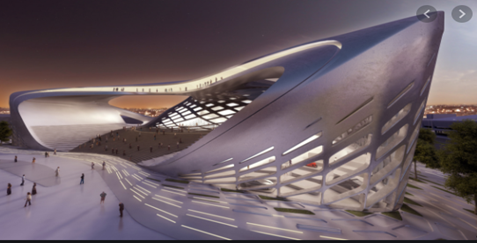Introduction
When you think of building design what comes to mind? Perhaps an architect putting pencil to paper in a series of 3D drawings which do not fully do the design justice. To the untrained eye, the original drawings filled with dimensions, different perspectives, and scales can make it difficult for the client to see whether or not their vision has been accurately depicted.
This is now changing with the rapid development of digital solutions such as BIM, Virtual Reality & AI. The emergence of these three applications for the architecture of new buildings has been a revolution in the last few years. They will soon become an instrumental part of the design process of a building.
The design industry which is has been previously driven by the old pen and paper/3D models which would now be considered a “brick and mortar” technique. But the big players in this game are still struggling to adapt to the newer processes in order to convince the client that these processes will create a finished article that will surpass the 2D or 3D representations of old. These techniques like BIM modeling, VR & AI can and will help to transform the industry.
Throughout this article, we are going to look at the possibilities that are attached to these three processes: BIM, VR & AI, We will look at each in detail and relay the benefits of designing buildings using these methods. We will also look at how we expect the industry to grow once there are both accepted and become common practice.
BIM

Building Information Modelling (BIM) is a revolutionary 3D model-based process that combines the architecture, engineering, and construction aspects into one vision. It’s in a sense a simple idea, using this technique a single digital model of the building to be designed is created so that everyone from the client to the architect to the builders themselves can input it. The BIM process is more about the service/process itself than the product. But the process itself can and will lead to alterations in the design of the building. The industry is changing we are seeing more software such as CAD adding additional benefits but BIM modeling and others such as VR and AI are surpassing this.
BIM allows us to strategically analyze the performance of the building, and budget control but most beneficial is the fact that BIM provides immersive Virtual Reality experiences and animations adding to the client’s experience. BIM has progressed from the Cad drawings brought into PDF covering the basic pictures to 3D CAD concepts being stored on a computer to produce more PDFs with the model itself usually being stored on one computer to a completely collaborative effort. Each member of the building design team uses a complete and single 3D model which is held in a shared location. All team members including builders, suppliers, contractors, architects, and the client themselves can access and modify the model. Each step is clearly visualized and by doing this we are removing a huge amount of risk that would typically accompany building design.
Another benefit of BIM is how it cuts down the time-consuming tasks of work drawings this is critical time saved during the design phase of the project. It highly enhanced the process allowing engineers, architects, and major stakeholders to merge models into one decisive model. Obviously, this encourages collaboration and transparency through every stage of the design. The 3D model created by BIM allows us to create a visual walkthrough of the building a more comprehensive view than a simple PDF of CAD drawing, this allows us to cut down time getting sign-offs and working out these issues earlier saving time and money at the construction phase. BIM is a great tool for the design phase of buildings and throughout the entire lifecycle of the project but when paired with other digital solutions such as VR or AI the possibilities are astronomical.
VR in Building Design

As we know, it takes a huge number of team members to bring a building design from concept to modeling to roots in the ground. And as with BIM, Virtual Reality (VR) allows designers, architects engineers, and most importantly the client get to add their own input and perspective to the conceptual design. VR allows us to create a real-life feel for the project which is highly beneficial to all participants. For a long time, virtual worlds have existed in the realm of Call of Duty or Fifa, but these virtual worlds as excellent as they may be should not be the only area that VR excels in. That is becoming the case, these tools once meant for the avid gamer are now becoming game-changers in building design.
VR technologies touch upon all aspects of architecture and engineering. Architects can create a concept using VR allowing the firm which will be bidding on that very concept to see a real building in an unbuilt area. This creates an advantage for all sides, during this walkthrough the client can visualize whether the architect has captured their vision accurately or if there are changes they would like to make.
Let us look at an example, Croke Park in Ireland prior to building. Architects & Engineers can come together to present a model of the exact stadium using virtual realities. Why would this be of benefit? In order for a stadium to be successful, we need to ensure that the spectators’ experience will be heightened by the design. Using VR we can view how the spectator can view the pitch from each seat whether it be the Hill or the Hogan but also beneficial in that private boxes available at such stadiums could even be sold prior to the build. You can even get advice from local gardai and security as to how the building design would work to crowd control and any security issues. VR is evolving to such a stage that we can use the technology to simulate flooding or a fire, environments that would be impossible to simulate in real-world scenarios. The changes can be made prior to construction which saves both time and cost for everyone involved, a win-win. There are VR technologies being released in conjunction with BIM models that create a comprehensive 3D model which retains all data and requires little to no experience in order to navigate.
AI in Building Design

Artificial Intelligence (AI), everyone is starting to see how AI is changing the face of industries like manufacturing or medicine but how are these changes going to come across the building design sector? How can Artificial Intelligence change how we design buildings and more? There are worries across the sectors about how AI could be negative and how it could remove the need for design and inspiration, but we can look at it as a positive. We are going to look at ways in which AI could prove to tackle the more time-consuming tasks that do not necessarily need that creative spark which the human mind has. In the following, we are going to look at some ways in which AI will do just that.
AI can use data and manipulate it to make decisions and or recommendations which are crucial in the design phase especially early on. The early stages of a project involve countless hours of study and research, both of new data and past projects. Ai can take an unlimited amount of data and compare and contrast ideas with ease. This cuts out a huge workload on the architectural side. Take again the stadium example used above, in the past architects and designers would have to take into account planning permissions, stadium codes, and security restrictions. Providing research on this would take a lot of work, AI has the ability to pull all this data nearly instantly.
Next let’s look at Parametric Architecture, over the last few years we have seen this technique used around the world of design. What is Parametric Architecture in terms of building design> Well it’s basically a design system that allows you to envision building structures that before the use of this software would not have been possible. Like the arcs of entryways or a lot of the Dubai skyline. Architects can freely use this in order to shape their buildings in the way they see fit.
Smart cities are no longer a thing of the distant future, the way cities are looking right now could be very different in the near future. The reason perhaps they have not changed in a long time is due to the countless amount of research needed in order to precision plan the revamp of a city. The use of AI is going to change this and fast-track our way to these smart cities. Smart cities will be created using real hands-on data and feedback. Things like the 5-hour traffic jams in LA will become a thing of the past. The use of smartphones, smart cars, and smart houses are all already on the market why not put them to use to contribute to the bigger picture? This is where AI is going to really thrive in order to improve the design of buildings and cities in order to enhance human life.
In conclusion, the use of BIM, Virtual Reality, and Artificial Intelligence in building design is becoming more and more frequent. An industry that is renowned for its old-fashioned mannerisms is slowly starting to realize that these breakthroughs in technology although based on the brick and mortar methods are there to accelerate the process, increase productivity, and enhance both client and team satisfaction. The digital revolution in construction is starting and we will only reap the rewards.
